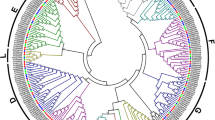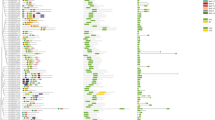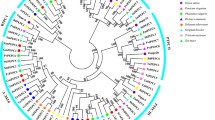Abstract
Protein phosphatase 2Cs (PP2Cs) belong to the largest protein phosphatase family in plants. Some members have been described as being negative modulators of plant growth and development, as well as responses to hormones and environmental stimuli. However, little is known about the members of PP2C clade D, which may be involved in the regulation of signaling pathways, especially in response to saline and alkali stresses. Here, we identified 13 PP2C orthologs from the wild soybean (Glycine soja) genome. We examined the sequence characteristics, chromosome locations and duplications, gene structures, and promoter cis-elements of the PP2C clade D genes in Arabidopsis and wild soybean. Our results showed that GsPP2C clade D (GsAPD) genes exhibit more gene duplications than AtPP2C clade D genes. Plant hormone and abiotic stress-responsive elements were identified in the promoter regions of most PP2C genes. Moreover, we investigated their expression patterns in roots, stems, and leaves. Quantitative real-time PCR analyses revealed that the expression levels of representative GsPP2C and AtPP2C clade D genes were significantly influenced by alkali and salt stresses, suggesting that these genes might be associated with or directly involved in the relevant stress signaling pathways. Our results established a foundation for further functional characterization of PP2C clade D genes in the future.






Similar content being viewed by others
References
Alhendawi R, Romheld V, Krikby E, Marschner H (1997) Influence of increasing bicarbonate concentrations on plant growth, organic acid accumulation in roots and iron uptake by barley, sorghum, and maize. J Plant Nutr 20(12):1731–1753
Banerjee A, Roychoudhury A (2017) Abscisic-acid-dependent basic leucine zipper (bZIP) transcription factors in plant abiotic stress. Protoplasma 254(1):3–16. https://doi.org/10.1007/s00709-015-0920-4
Benhamed M, Bertrand C, Servet C, Zhou DX (2006) Arabidopsis GCN5, HD1, and TAF1/HAF2 interact to regulate histone acetylation required for light-responsive gene expression. Plant Cell 18(11):2893–2903. https://doi.org/10.1105/tpc.106.043489
Blanc G, Hokamp K, Wolfe KH (2003) A recent polyploidy superimposed on older large-scale duplications in the Arabidopsis genome. Genome Res 13(2):137–144. https://doi.org/10.1101/gr.751803
Bowers JE, Chapman BA, Rong JK, Paterson AH (2003) Unravelling angiosperm genome evolution by phylogenetic analysis of chromosomal duplication events. Nature 422(6930):433–438. https://doi.org/10.1038/nature01521
Chen C, Sun X, Duanmu H, Zhu D, Yu Y, Cao L, Liu A, Jia B, Xiao J, Zhu Y (2015) GsCML27, a gene encoding a calcium-binding Ef-hand protein from Glycine soja, plays differential roles in plant responses to bicarbonate, salt and osmotic stresses. PLoS One 10(11):e0141888. https://doi.org/10.1371/journal.pone.0141888
Christmann A, Moes D, Himmelbach A, Yang Y, Tang Y, Grill E (2006) Integration of abscisic acid signalling into plant responses. Plant Biol 8(3):314–325. https://doi.org/10.1055/s-2006-924120
Chung WH, Jeong N, Kim J, Lee WK, Lee YG, Lee SH, Yoon W, Kim JH, Choi IY, Choi HK, Moon JK, Kim N, Jeong SC (2014) Population structure and domestication revealed by high-depth resequencing of Korean cultivated and wild soybean genomes. DNA Res 21(2):153–167. https://doi.org/10.1093/dnares/dst047
Czechowski T, Stitt M, Altmann T, Udvardi MK, Scheible WR (2005) Genome-wide identification and testing of superior reference genes for transcript normalization in Arabidopsis. Plant Physiol 139(1):5–17. https://doi.org/10.1104/pp.105.063743
DuanMu H, Wang Y, Bai X, Cheng S, Deyholos MK, Wong GK, Li D, Zhu D, Li R, Yu Y, Cao L, Chen C, Zhu Y (2015) Wild soybean roots depend on specific transcription factors and oxidation reduction related genesin response to alkaline stress. Funct Integr Genomics 15(6):651–660. https://doi.org/10.1007/s10142-015-0439-y
Fuchs S, Grill E, Meskiene I, Schweighofer A (2013) Type 2C protein phosphatases in plants. FEBS J 280(2):681–693. https://doi.org/10.1111/j.1742-4658.2012.08670.x
Ge Y, Li Y, Zhu YM, Bai X, Lv DK, Guo DJ, Ji W, Cai H (2010) Global transcriptome profiling of wild soybean (Glycine soja) roots under NaHCO3 treatment. BMC Plant Biol 10:153. https://doi.org/10.1186/1471–2229–10-153
Gevaudant F, Duby G, von Stedingk E, Zhao R, Morsomme P, Boutry M (2007) Expression of a constitutively activated plasma membrane H+-ATPase alters plant development and increases salt tolerance. Plant Physiol 144(4):1763–1776. https://doi.org/10.1104/pp.107.103762
Gu Z, Cavalcanti A, Chen FC, Bouman P, Li WH (2002) Extent of gene duplication in the genomes of Drosophila, nematode, and yeast. Mol Biol Evol 19(3):256–262
Hernandez-Garcia CM, Finer JJ (2014) Identification and validation of promoters and cis-acting regulatory elements. Plant Sci 217-218:109–119. https://doi.org/10.1016/j.plantsci.2013.12.007
Hu B, Jin J, Guo AY, Zhang H, Luo J, Gao G (2015) GSDS 2.0: an upgraded gene feature visualization server. Bioinformatics 31(8):1296–1297. https://doi.org/10.1093/bioinformatics/btu817
Huang GT, Ma SL, Bai LP, Zhang L, Ma H, Jia P, Liu J, Zhong M, Guo ZF (2012) Signal transduction during cold, salt, and drought stresses in plants. Mol Biol Rep 39(2):969–987. https://doi.org/10.1007/s11033-011-0823-1
Huis R, Hawkins S, Neutelings G (2010) Selection of reference genes for quantitative gene expression normalization in flax (Linum usitatissimum L.) BMC Plant Biol 10:71. https://doi.org/10.1186/1471–2229–10-71
Kim MY, Lee S, Van K, Kim TH, Jeong SC, Choi IY, Kim DS, Lee YS, Park D, Ma J, Kim WY, Kim BC, Park S, Lee KA, Kim DH, Kim KH, Shin JH, Jang YE, Kim KD, Liu WX, Chaisan T, Kang YJ, Lee YH, Kim KH, Moon JK, Schmutz J, Jackson SA, Bhak J, Lee SH (2010) Whole-genome sequencing and intensive analysis of the undomesticated soybean (Glycine soja Sieb. and Zucc.) genome. Proc Natl Acad Sci U S A 107(51):22032–22037. https://doi.org/10.1073/pnas.1009526107
Li Z, Zhen Z, Guo K, Harvey P, Li J, Yang H (2016) MAPK-mediated enhanced expression of vacuolar H(+)-ATPase confers the improved adaption to NaCl stress in a halotolerate peppermint (Mentha piperita L.) Protoplasma 253(2):553–569. https://doi.org/10.1007/s00709-015-0834-1
Liu H, Tsugama D, Liu S, Takano T (2013) Functional analysis of a type-2C protein phosphatase (AtPP2C52) in Arabidopsis thaliana genomics and applied. Biology 4(1):1–7
MacKintosh C, Coggins J, Cohen P (1991) Plant protein phosphatases. Subcellular distribution, detection of protein phosphatase 2C and identification of protein phosphatase 2A as the major quinate dehydrogenase phosphatase. Biochem J 273(Pt 3):733–738
Narusaka Y, Nakashima K, Shinwari ZK, Sakuma Y, Furihata T, Abe H, Narusaka M, Shinozaki K, Yamaguchi-Shinozaki K (2003) Interaction between two cis-acting elements, ABRE and DRE, in ABA-dependent expression of Arabidopsis rd29A gene in response to dehydration and high-salinity stresses. Plant J 34(2):137–148. https://doi.org/10.1046/j.1365-313X.2003.01708.x
Park SY, Fung P, Nishimura N, Jensen DR, Fujii H, Zhao Y, Lumba S, Santiago J, Rodrigues A, Chow TF, Alfred SE, Bonetta D, Finkelstein R, Provart NJ, Desveaux D, Rodriguez PL, McCourt P, Zhu JK, Schroeder JI, Volkman BF, Cutler SR (2009) Abscisic acid inhibits type 2C protein phosphatases via the PYR/PYL family of START proteins. Science 324(5930):1068–1071. https://doi.org/10.1126/science.1173041
Passricha N, Saifi S, Ansari MW, Tuteja N (2017) Prediction and validation of cis-regulatory elements in 5' upstream regulatory regions of lectin receptor-like kinase gene family in rice. Protoplasma 254(2):669–684. https://doi.org/10.1007/s00709-016-0979-6
Phang TH, Shao G, Lam HM (2008) Salt tolerance in soybean. J Integr Plant Biol 50(10):1196–1212. https://doi.org/10.1111/j.1744-7909.2008.00760.x
Qi X, Li MW, Xie M, Liu X, Ni M, Shao G, Song C, Kay-Yuen Yim A, Tao Y, Wong FL, Isobe S, Wong CF, Wong KS, Xu C, Li C, Wang Y, Guan R, Sun F, Fan G, Xiao Z, Zhou F, Phang TH, Liu X, Tong SW, Chan TF, Yiu SM, Tabata S, Wang J, Xu X, Lam HM (2014) Identification of a novel salt tolerance gene in wild soybean by whole-genome sequencing. Nat Commun 5:4340. https://doi.org/10.1038/ncomms5340
Rober-Kleber N, Albrechtova JTP, Fleig S, Huck N, Michalke W, Wagner E, Speth V, Neuhaus G, Fischer-Iglesias C (2003) Plasma membrane H+-ATPase is involved in auxin-mediated cell elongation during wheat embryo development. Plant Physiol 131(3):1302–1312. https://doi.org/10.1104/pp.013466
Sanchita, Dhawan SS, Sharma A (2014) Analysis of differentially expressed genes in abiotic stress response and their role in signal transduction pathways. Protoplasma 251(1):81–91. https://doi.org/10.1007/s00709-013-0528-5
Santiago J, Dupeux F, Round A, Antoni R, Park SY, Jamin M, Cutler SR, Rodriguez PL, Marquez JA (2009) The abscisic acid receptor PYR1 in complex with abscisic acid. Nature 462(7273):665–668. https://doi.org/10.1038/nature08591
Schultz J, Copley RR, Doerks T, Ponting CP, Bork P (2000) SMART: a web-based tool for the study of genetically mobile domains. Nucleic Acids Res 28(1):231–234
Schweighofer A, Hirt H, Meskiene L (2004) Plant PP2C phosphatases: emerging functions in stress signaling. Trends Plant Sci 9(5):236–243. https://doi.org/10.1016/j.tplants.2004.03.007
Schweighofer A, Kazanaviciute V, Scheikl E, Teige M, Doczi R, Hirt H, Schwanninger M, Kant M, Schuurink R, Mauch F, Buchala A, Cardinale F, Meskiene I (2007) The PP2C-type phosphatase AP2C1, which negatively regulates MPK4 and MPK6, modulates innate immunity, jasmonic acid, and ethylene levels in Arabidopsis. Plant Cell 19(7):2213–2224. https://doi.org/10.1105/tpc.106.049585
Servet C, Benhamed M, Latrasse D, Kim W, Delarue M, Zhou DX (2008) Characterization of a phosphatase 2C protein as an interacting partner of the histone acetyltransferase GCN5 in Arabidopsis. BBA-Gene Regul Mech 1779(6–7):376–382. https://doi.org/10.1016/j.bbagrm.2008.04.007
Shang H, Li W, Zou C, Yuan Y (2013) Analyses of the NAC transcription factor gene family in Gossypium raimondii Ulbr.: chromosomal location, structure, phylogeny, and expression patterns. J Integr Plant Biol 55(7):663–676. https://doi.org/10.1111/jipb.12085
Singh A, Giri J, Kapoor S, Tyagi AK, Pandey GK (2010) Protein phosphatase complement in rice: genome-wide identification and transcriptional analysis under abiotic stress conditions and reproductive development. BMC Genomics 11:435. https://doi.org/10.1186/1471–2164–11-435
Song SK, Clark SE (2005) POL and related phosphatases are dosage-sensitive regulators of meristem and organ development in Arabidopsis. Dev Biol 285(1):272–284. https://doi.org/10.1016/j.ydbio.2005.06.020
Song SK, Lee MM, Clark SE (2006) POL and PLL1 phosphatases are CLAVATA1 signaling intermediates required for Arabidopsis shoot and floral stem cells. Development 133(23):4691–4698. https://doi.org/10.1242/dev.02652
Sonnhammer EL, Eddy SR, Durbin R (1997) Pfam: a comprehensive database of protein domain families based on seed alignments. Proteins 28(3):405–420
Spartz AK, Ren H, Park MY, Grandt KN, Lee SH, Murphy AS, Sussman MR, Overvoorde PJ, Gray WM (2014) SAUR inhibition of PP2C-D phosphatases activates plasma membrane H+-ATPases to promote cell expansion in Arabidopsis. Plant Cell 26(5):2129–2142. https://doi.org/10.1105/tpc.114.126037
Sun X, Luo X, Sun M, Chen C, Ding X, Wang X, Yang S, Yu Q, Jia B, Ji W, Cai H, Zhu Y (2014) A Glycine soja 14-3-3 protein GsGF14o participates in stomatal and root hair development and drought tolerance in Arabidopsis thaliana. Plant Cell Physiol 55(1):99–118. https://doi.org/10.1093/pcp/pct161
Sun M, Jia B, Cui N, Wen Y, Duanmu H, Yu Q, Xiao J, Sun X, Zhu Y (2016) Functional characterization of a Glycine soja Ca(2+)ATPase in salt-alkaline stress responses. Plant Mol Biol 90(4–5):419–434. https://doi.org/10.1007/s11103-015-0426-7
Tamura K, Peterson D, Peterson N, Stecher G, Nei M, Kumar S (2011) MEGA5: molecular evolutionary genetics analysis using maximum likelihood, evolutionary distance, and maximum parsimony methods. Mol Biol Evol 28(10):2731–2739. https://doi.org/10.1093/molbev/msr121
Tovar-Mendez A, Miernyk JA, Hoyos E, Randall DD (2014) A functional genomic analysis of Arabidopsis thaliana PP2C clade D. Protoplasma 251(1):265–271. https://doi.org/10.1007/s00709-013-0526-7
Tuteja N (2007) Mechanisms of high salinity tolerance in plants. Methods Enzymol 428:419–438. https://doi.org/10.1016/S0076-6879(07)28024-3
Wang Y, Yang C, Liu G, Jiang J (2007) Development of a cDNA microarray to identify gene expression of Puccinellia tenuiflora under saline-alkali stress. Plant Physiol Biochem 45(8):567–576. https://doi.org/10.1016/j.plaphy.2007.05.006
Xue T, Wang D, Zhang S, Ehlting J, Ni F, Jakab S, Zheng C, Zhong Y (2008) Genome-wide and expression analysis of protein phosphatase 2C in rice and Arabidopsis. BMC Genomics 9:550. https://doi.org/10.1186/1471-2164-9-550
Yang SH, Zhang XH, Yue JX, Tian DC, Chen JQ (2008) Recent duplications dominate NBS-encoding gene expansion in two woody species. Mol Gen Genomics 280(3):187–198. https://doi.org/10.1007/s00438-008-0355-0
Ying G, Zhu Y, De-Kang L, Dong T, Wang W (2009) Research on responses of wild soybean to alkaline stress. Pratacultural Sci 26:47–52
Zeng QY, Yang CY, Ma QB, Li XP, Dong WW, Nian H (2012) Identification of wild soybean miRNAs and their target genes responsive to aluminum stress. BMC Plant Biol 12:182. https://doi.org/10.1186/1471–2229–12-182
Zhang LM, Liu XG, XN Q, Yu Y, Han SP, Dou Y, YY X, Jing HC, Hao DY (2013) Early transcriptomic adaptation to Na(2)CO(3) stress altered the expression of a quarter of the total genes in the maize genome and exhibited shared and distinctive profiles with NaCl and high pH stresses. J Integr Plant Biol 55(11):1147–1165. https://doi.org/10.1111/jipb.12100
Zhang J, Yang D, Li M, Shi L (2016) Metabolic profiles reveal changes in wild and cultivated soybean seedling leaves under salt stress. PLoS One 11(7):e0159622. https://doi.org/10.1371/journal.pone.0159622
Zhu JK (2001) Plant salt tolerance. Trends Plant Sci 6(2):66–71
Zhu D, Bai X, Chen C, Chen Q, Cai H, Li Y, Ji W, Zhai H, Lv D, Luo X, Zhu Y (2011) GsTIFY10, a novel positive regulator of plant tolerance to bicarbonate stress and a repressor of jasmonate signaling. Plant Mol Biol 77(3):285–297. https://doi.org/10.1007/s11103-011-9810-0
Acknowledgements
This work was supported by the Heilongjiang Provincial Higher School Science and Technology Innovation Team Building Program (2011TD005), National Natural Science Foundation of China (31501331), and Advanced Talents Foundation of QAU (6631115032).
Author contribution statements
Chao Chen, Yang Yu, Huizi Duanmu, and Lei Cao performed the experiment, analyzed data; Chao Chen, Yu Yang, and Dan Zhu wrote the manuscript; Beidong Liu, Xiaoli Sun, and Zaib-un-Nisa edited the manuscript; and Qiang Li, Yanming Zhu, and Xiaodong Ding provided ideas, designed the research; all authors read and approved the final manuscript.
Author information
Authors and Affiliations
Corresponding author
Ethics declarations
Conflicts of interest
The authors declare that they have no conflict of interest.
Additional information
Handling Editor: Bhumi Nath Tripathi
Electronic supplementary material
Supplemental Table 1
Gene-specific primers used for quantitative RT-PCR assays (DOCX 16 kb)
Supplemental Table 2
DNA sequence of cis-acting regulatory elements (DOCX 14 kb)
Supplemental Table 3
Distribution of cis-acting elements on the promoters of PP2C clade D genes in soybean (DOCX 14 kb)
Supplemental Fig. 1
Sequence analysis of GmPP2C and GsPP2C clade D proteins. Multiple sequence alignments of the full-length amino acid sequences of GmPP2C and GsPP2C clade D. Sequences were aligned using clustalx1.83. (JPEG 3492 kb)
High resolution image
(TIFF 19293 kb)
Supplemental Fig. 2
Phylogenetic relationships and exon-intron structure analysis of PP2C clade D genes in cultivated and wild soybean. The phylogenetic tree was produced using MEGA 5.0 by N-J method. Bootstrap values based on 1000 replications for each branch. Gene structure analysis of PP2C clade D was performed by using GSDS online tools. (JPEG 142 kb)
High resolution image
(TIFF 6364 kb)
Supplemental Fig. 3
Correlation with PP2C clade D genes in wild soybean (a) and Arabidopsis (b). The correlation of the gene expression patterns measured from root, stems and leaves in wild soybean and Arabidopsis plants. The relative expression levels were detected by qRT-PCR. r ≥ 8: two variables are highly correlation. (JPEG 225 kb)
High resolution image
(TIFF 247 kb)
Supplemental Fig. 4
Expression analysis of four PP2C clade D genes in soybean under alkaline and salt treatments. Total RNA samples were extracted from 15-day-old soybean seedlings under 50 mM NaHCO3 and 200 mM NaCl treatments. The relative expression levels were detected using qRT-PCR. GAPDH was used as an internal control. Statistical analyses were performed by one-way ANOVA with Bonferroni post-test. *P < 0.05, **P < 0.01, as compared with the control before treatment (0 h). (JPEG 120 kb)
High resolution image
(TIFF 236 kb)
Rights and permissions
About this article
Cite this article
Chen, C., Yu, Y., Ding, X. et al. Genome-wide analysis and expression profiling of PP2C clade D under saline and alkali stresses in wild soybean and Arabidopsis . Protoplasma 255, 643–654 (2018). https://doi.org/10.1007/s00709-017-1172-2
Received:
Accepted:
Published:
Issue Date:
DOI: https://doi.org/10.1007/s00709-017-1172-2




